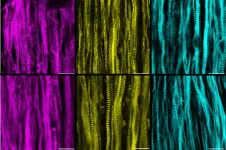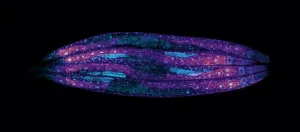(Press-News.org) DURHAM, N.C. – Biomedical engineers at Duke University have developed a new technique to better understand and test treatments for a group of extremely rare muscle disorders called dysferlinopathy or limb girdle muscular dystrophies 2B (LGMD2B). The approach grows complex, functional 3D muscle tissue from stem cells in the laboratory, creating a platform that replicates patient symptoms and treatment responses.
In its debut study, researchers reveal some of the biological mechanisms underlying the characteristic loss of mobility caused by LGMD2B. They also demonstrate that a combination of existing treatments may be able to alleviate some of the worst symptoms of the disease.
The results appear online June 18 in the journal Advanced Science.
LGMD2B affects only about eight people per million around the world. Unlike it’s more well-known and more common cousin Duchenne muscular dystrophy, the disease affects both men and women, presents later in life -- in the late teens or early 20s -- and is rarely fatal. However, LGMD2B patients develop severe weakness in the legs and shoulders, typically requiring them to use wheelchairs for the rest of their lives.
Caused by a genetic disorder, LGMD2B stops the body from creating a fully functional form of a protein called dysferlin. There are currently no approved treatments or cures. Part of the reason for this lack of options is the many functions of dysferlin, including sealing holes in muscle membranes, regulating calcium balances required for muscle contraction and controlling cellular metabolism. And for reasons unknown, affected muscles initially accumulate fat within the muscle fibers themselves before degenerating and ultimately being replaced by fat cells.
“This phenomenon is very rare even for muscular dystrophies,” said Nenad Bursac, professor of biomedical engineering at Duke. “It’s a burning question within the community of why that happens.”
One of the challenges facing researchers trying to solve these problems is that the mouse model used to approximate LGMD2B shows very mild symptoms compared to patients. Mice with the disease are still able to walk, and it does not present until nearly a year into their two-year long lifespan, making studies of the disease extremely slow. Dysferlin is expressed in other cell types, and blood levels of metabolic fuels such as cholesterol are also altered in mice and patients. Together, this complicates LGMD2B research by making it difficult to assess what cell types are responsible for the disease and if metabolic changes are due to the loss of dysferlin itself or whole-body effects.
To get around these challenges, Bursac and his research scientist Alastair Khodabukus turned to an engineered muscle platform that they have been developing for nearly a decade. The Bursac Lab was the first to grow contracting, functional human skeletal muscle in a Petri dish and has been improving its processes ever since to enable studies of muscle strength, metabolism and repair. This system allowed them to focus their study on only the effects of dysferlin on skeletal muscle without the complications of other cell types or altered blood metabolite profiles.
In the study, the researchers began with induced pluripotent stem cells (IPSCs) derived from patients living with LGMD supplied by The Jain Foundation, a charity focused on finding a cure for LGMD2B. Using their muscle-growing techniques, the lab matured these stem cells into muscle fibers and ran them through a battery of tests over the course of six weeks.
Like muscles found in patients themselves, the lab-grown versions displayed a wide variety of issues.
“Overall, our model repeated a lot of the clinical manifestations of the disease and observations made in real patients, but it was all done in a Petri dish,” said Bursac. “We’ve been able to gain new insights into the muscle-specific aspects of the disease.”
The researchers discovered that the loss in muscle strength was not the result of deficiencies in muscle structure or size, but in its handling of calcium. Muscle contractions are physically caused by reservoirs of calcium in muscle cells being released and binding to muscle proteins. Tests showed that the diseased muscle cells had sprung leaks in their calcium reserves, resulting in less calcium to release and weaker contractions.
The researchers also showed that the lack of dysferlin caused damage to the muscle cells to go unrepaired, and that an inability to burn fatty acids for energy production was at least partially to blame for the accumulation of fat within muscle fibers that has long puzzled the medical community.
“We replicated something seen in patients and showed that it’s not due to environmental factors within the body, but issues within the muscle itself,” Khodabukus said.
The researchers then tested the effects of two drug candidates to potentially treat the disease that have been identified through mouse models but have not yet been tested in humans. One called dantrolene is supposed to stop calcium from leaking from muscle cells’ reservoirs. The second, called vamorolone, was recently approved for use with Duchenne muscular dystrophy patients, although researchers do not fully understand how it works.
Together, the drugs prevented the calcium leak and helped the cell membrane repair itself, restoring much of the muscles’ strength. And while they also helped reduce the amount of fat accumulated within the muscles, they did not fully prevent it, nor did they help the muscles efficiently burn fats for fuel.
Moving forward, the group is planning to add immune and fat cells to their experiments for greater complexity. They also are looking to further understand disruptions to cellular metabolism and to find new drugs that fully restore all strength, repair and metabolic deficit.
“Right now, we have a basic muscle-only system, which is great to see the effects of the disease within the muscle itself, but what is also important is the crosstalk between immune cells, fat cells and muscle cells,” Khodabukus said. “By building out our system more, we’ll hopefully be able to fully figure out what is driving the loss of muscle and its replacement by fat in these patients.”
This research was supported by the National Institutes of Health (UG3TR002142, U01EB028901, R01AR070543, R01AR079223, R01ARO82979, R21AR078269, UH3TR002142) and the Jain Foundation.
“Bioengineered model of human LGMD2B skeletal muscle reveals roles of intracellular calcium overload in contractile and metabolic dysfunction in dysferlinopathy.” Alastair Khodabukus, Neel K. Prabhu, Taylor Roberts, Meghan Buldo, Amber Detwiler, Zachary D.Fralish, Megan E. Kondash, George A. Truskey, Timothy R. Koves, Nenad 7 Bursac. Advanced Science, 2024. DOI: 10.1002/advs.202400188
Link: https://onlinelibrary.wiley.com/doi/10.1002/advs.202400188
# # #
END
Lab-grown muscles reveal mysteries of rare muscle diseases
Muscles grown from stem cells taken from patients with limb girdle muscular dystrophy 2B (LGMD2B) respond positively to potential treatments
2024-06-21
ELSE PRESS RELEASES FROM THIS DATE:
Primary hepatic angiosarcoma: Treatment options for a rare tumor
2024-06-21
“[...] PHA is a rare yet aggressive mesenchymal tumor of the liver, which requires a multi-disciplinary approach to achieve the best patient outcomes.”
BUFFALO, NY- June 21, 2024 – A new editorial paper was published in Oncoscience (Volume 11) on May 20, 2024, entitled, “Primary hepatic angiosarcoma: Treatment options for a rare tumor.”
In this new editorial, researchers Gregory L. Guzik and Ankit Mangla from University Hospitals Cleveland Medical Center, University Hospitals Seidman Cancer ...
Research finds causal evidence tying cerebral small-vessel disease to Alzheimer’s, dementia
2024-06-21
SAN ANTONIO, June 21, 2024 – Research led by in part by The University of Texas Health Science Center at San Antonio (UT Health San Antonio) finds that the most common cerebral small-vessel disease feature seen in brain magnetic resonance imaging is a primary vascular factor associated with dementia risk.
Results of the major international study emphasize the significance of that feature, known as white matter hyperintensity (WMH) burden, in preventive strategies for dementia.
“Our findings provide converging evidence that WMH is a major vascular factor ...
Navigating the Pyrocene: Recent Cell Press papers on managing fire risk
2024-06-21
As wildfires become more intense and the fire season grows longer across parts of the world, humans will need to adapt. In this collection of papers from Cell Press journals One Earth and Cell Reports Sustainability, an intersection of fire management researchers comment on what needs to change to ensure we can collaborate across stakeholders in a more fire-resistant future.
The papers are publishing in advance of a Cell Press 50th Anniversary sustainabiltiy forum on the topic of “Navigating the Pyrocene: Managing fire risk in a warming world.” The virtual event, free to register, takes place Thursday, July 11, 2024 at 11:00 am ET.
This ...
Restoring the Great Salt Lake would have environmental justice as well as ecological benefits
2024-06-21
Inland seas around the world are drying up due to increasing human water use and accelerating climate change, and their desiccation is releasing harmful dust that pollutes the surrounding areas during acute dust storms. Using the Great Salt Lake in Utah as a case study, researchers show that dust exposure was highest among Pacific Islanders and Hispanic people and lower in white people compared to all other racial/ethnic groups, and higher for individuals without a high school diploma. Restoring the lake ...
Cannabis, tobacco use, and COVID-19 outcomes
2024-06-21
About The Study: The findings of this cohort study suggest that cannabis use may be an independent risk factor for COVID-19–related complications, even after considering cigarette smoking, vaccination status, comorbidities, and other risk factors.
Corresponding Author: To contact the corresponding author, Li-Shiun Chen, M.D., M.P.H., Sc.D., email li-shiun@wustl.edu.
To access the embargoed study: Visit our For The Media website at this link https://media.jamanetwork.com/
(doi:10.1001/jamanetworkopen.2024.17977)
Editor’s ...
A 5:2 intermittent fasting meal replacement diet and glycemic control for adults with diabetes
2024-06-21
About The Study: This randomized clinical trial of Chinese adults with overweight or obesity and with early type 2 diabetes found that an intermittent fasting plan consisting of two nonconsecutive fasting days and five days of habitual intake per week and meal replacement diet (5:2 MR) could improve glycemic outcomes and weight loss in the short term compared with metformin or empagliflozin, making it a promising initial intervention and early management for type 2 diabetes.
Corresponding Author: To contact the corresponding author, Lixin Guo, M.D., email glx1218@163.com.
To access the embargoed study: Visit ...
Scientists document self-propelling oxygen decline in the oceans
2024-06-21
Scientists from the University of Copenhagen have made significant strides in understanding ancient ocean anoxia, with potential insights for today's marine environments.
500 million years ago the so-called Cambrian ‘SPICE’ event made oxygen levels in the oceans drop dramatically.
Now, researchers from the University of Copenhagen have investigated how large-scale ocean anoxia, or oxygen-depleted conditions, developed during the event, and its potential consequences today.
In the study, titled "Cascading oxygen loss shorewards in the oceans – insights from the Cambrian SPICE event" published in OneEarth ...
Activating molecular target reverses multiple hallmarks of aging
2024-06-21
HOUSTON ― Researchers at The University of Texas MD Anderson Cancer Center have demonstrated that therapeutically restoring ‘youthful’ levels of a specific subunit of the telomerase enzyme can significantly reduce the signs and symptoms of aging in preclinical models. If these findings are confirmed in clinical studies, there may be therapeutic implications for age-related diseases such as Alzheimer’s, Parkinson’s, heart disease and cancer.
The study, published today in Cell, identified a small molecule compound ...
Cannabis use tied to increased risk of severe COVID-19
2024-06-21
As the deadly disease that came to be known as COVID-19 started spreading in late 2019, scientists rushed to answer a critical question: Who is most at risk?
They quickly recognized that a handful of characteristics — including age, smoking history, high body mass index (BMI) and the presence of other diseases such as diabetes — made people infected with the virus much more likely to become seriously ill and even die. But one suggested risk factor remains unconfirmed more than four years later: cannabis use. Evidence has emerged over time indicating both ...
How to make ageing a ‘fairer game’ for all wormkind
2024-06-21
Why do some people live for longer than others? The genes in our DNA sequence are important, helping avoid disease or maintain general health, but differences in our genome sequence alone explain less than 30% of the natural variance of human life expectancy.
Exploring how ageing is influenced at the molecular level could shed light on lifespan variation, but generating data at the speed, scale and quality necessary to study this in humans is unfeasible. Instead, researchers turn to worms (Caenorhabditis elegans). Humans share a lot of biology with these small creatures, who also have a large, natural variation in lifespan.
Researchers ...
LAST 30 PRESS RELEASES:
Can community awareness campaigns in low-resource areas improve early diagnosis of colorectal cancer?
Stardust study resets how life’s atoms spread through space
Practical education: Clinical scenario-based program development
The impact of family dynamics on eating behaviour – how going home for Christmas can change how you eat
Tracing the quick synthesis of an industrially important catalyst
New software sheds light on cancer’s hidden genetic networks
UT Health San Antonio awarded $3 million in CPRIT grants to bolster cancer research and prevention efforts in South Texas
Third symposium spotlights global challenge of new contaminants in China’s fight against pollution
From straw to soil harmony: International team reveals how biochar supercharges carbon-smart farming
Myeloma: How AI is redrawing the map of cancer care
Manhattan E. Charurat, Ph.D., MHS invested as the Homer and Martha Gudelsky Distinguished Professor in Medicine at the University of Maryland School of Medicine
Insilico Medicine’s Pharma.AI Q4 Winter Launch Recap: Revolutionizing drug discovery with cutting-edge AI innovations, accelerating the path to pharmaceutical superintelligence
Nanoplastics have diet-dependent impacts on digestive system health
Brain neuron death occurs throughout life and increases with age, a natural human protein drug may halt neuron death in Alzheimer’s disease
SPIE and CLP announce the recipients of the 2025 Advanced Photonics Young Innovator Award
Lessons from the Caldor Fire’s Christmas Valley ‘Miracle’
Ant societies rose by trading individual protection for collective power
Research reveals how ancient viral DNA shapes early embryonic development
A molecular gatekeeper that controls protein synthesis
New ‘cloaking device’ concept to shield sensitive tech from magnetic fields
Researchers show impact of mountain building and climate change on alpine biodiversity
Study models the transition from Neanderthals to modern humans in Europe
University of Phoenix College of Doctoral Studies releases white paper on AI-driven skilling to reduce burnout and restore worker autonomy
AIs fail at the game of visual “telephone”
The levers for a sustainable food system
Potential changes in US homelessness by ending federal support for housing first programs
Vulnerability of large language models to prompt injection when providing medical advice
Researchers develop new system for high-energy-density, long-life, multi-electron transfer bromine-based flow batteries
Ending federal support for housing first programs could increase U.S. homelessness by 5% in one year, new JAMA study finds
New research uncovers molecular ‘safety switch’ shielding cancers from immune attack
[Press-News.org] Lab-grown muscles reveal mysteries of rare muscle diseasesMuscles grown from stem cells taken from patients with limb girdle muscular dystrophy 2B (LGMD2B) respond positively to potential treatments







